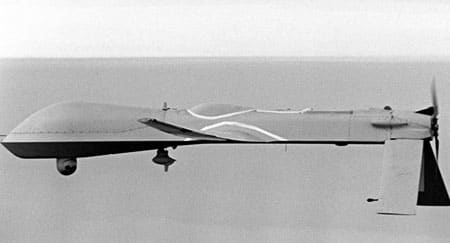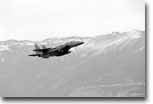Joseph J. Eash III explains how the rapid integration of advanced technologies into war-fighting systems helped the Allies during the Kosovo campaign.

The Predator: During the Kosovo campaign, Predators carried out surveillance in areas too dangerous for manned aircraft. (US DoD photo - 10Kb)
Operation Allied Force in Kosovo last year demonstrated the value of coalition operations. It also showed that technology is key to their success. Many of the innovations that were first used during the campaign were some of the fruits of a US Department of Defense programme that seeks to integrate new technology rapidly into war-fighting. To date, Allied participation has helped in the process. Expanding this cooperation could enable the improved capabilities that NATO is seeking in future multinational operations.
The value of coalition operations was seen in Kosovo. NATOs solidarity was central in compelling the Belgrade regime to accept its demands. It signalled a political resolve and moral force that was greater than any unilateral action could have mustered. Moreover, Operation Allied Force could not have been conducted without the efforts of the entire Alliance and depended on such Allied contributions as forces, bases, infra-structure and transit access.
Operation Allied Force was also militarily significant. It was NATOs largest combat operation to date, demonstrating significant prowess and featuring the most precise air campaign conducted in history, with a minimum of collateral damage.
Technology played a critical role in this military performance. New systems and capabilities were fielded for the first time in this campaign and integrated into new processes. The result was a multinational force that operated with speed and precision, able to find and hit opposing forces rapidly, while minimising friendly casualties.
Some of the innovations introduced in Kosovo were the result of a US Department of Defense initiative called the Advanced Concept Technology Demonstration Program. During the past five years, this programme has been harnessing technology to meet war-fighting needs. It brings together scientists and soldiers, who insert technology into an operational concept to see quickly what works and what does not. The programme is contributing to a revolution in military affairs and reducing time, risk and cost in acquisition.

(Belga photo - 11Kb)
Technological take-off: The Advanced Concept Technology Demonstration Program cuts the time, risk and cost of new war-fighting technology.
Since its inception, the programme has initiated 68 projects, of which, more than a third have benefited from Allied involvement. Some have resulted in a technological innovation for a particular theatre commander. Others have enabled a faster acquisition of systems than in the past. And, in other instances, they have revealed systems that do not work, helping avoid further expenditure.
These projects also focused on coalition warfare prior to Kosovo. One launched in 1998 is enabling the US Armys command and control systems to operate with those of Canada, France, Germany, Italy and the United Kingdom. It is developing and refining methods of exchanging information, using NATO standard messages, directly between national databases. Another project is helping ground, air and naval coalition forces in Korea synchronise deep strikes.
The Kosovo campaign created a great demand for many of the technologies developed in this programme. Approximately 20 per cent of its products were deployed, or prepared for deployment in support of Operation Allied Force. How some of these products were used provides a glimpse of future joint operations and attests to the programmes effectiveness.
In Kosovo, speed was essential. To put an end to the campaign of terror that was being waged by the Yugoslav Army, Serbian police and paramilitaries, the Alliance had to find and attack the Belgrade regimes ability to wage military operations faster than its forces could act.
Several products of the Advanced Concept Technology Demonstration Program were used to find enemy forces. One in particular was the Predator unmanned aerial vehicle. Remotely piloted by personnel hundreds of kilometres away, this aircraft carries video cameras and other sensing devices and can fly for as long as 40 hours. In Kosovo, Predators often flew over areas too dangerous for manned aircraft. They kept almost constant surveillance on enemy forces operating in open country and were also used to observe refugees and assess battle damage.
The Predator unmanned aerial vehicle a project that involved several nations was fielded after only 30 months of development. In this way, two years of testing were eliminated at a saving estimated to be greater than $10 million, without any loss of credibility in the Predators performance.
NATOs extensive surveillance during the Kosovo campaign increasingly drove Serbian forces into hiding, forcing them to rely extensively on camouflage and concealment. Though this made it more difficult for Alliance planes to find them, it also prevented their offensive employment. Moreover, such tactics are likely to be used increasingly by other potential enemies as sensors continue to improve.
The United States deployed technologies from a project called the Common Spectral Measurement and Signals Intelligence Exploitation Capability. This project has been working on technologies that can detect camouflage and threat vehicles, but its systems may also be used for such purposes as search and rescue, characterising terrain and detecting chemical and biological weapons. This capability is being achieved by a computer workstation that processes information from several spectral sensors.
Alliance forces used another product of the Advanced Concept Technology Demonstration Program to find and identify opposing forces. Called Precision Targeting Identification, this product was used to detect targets at greater ranges than previous detection and monitoring systems. Its infrared sensors find targets and a laser radar identifies them. The system was initiated to detect targets in congested areas such as in coastal regions and was previously used in counterdrug operations to detect boats smuggling cocaine.
Once targets were located, the information had to be rapidly passed to Alliance strike forces. One of the most useful means of doing this was a wide-band dissemination system developed by the Advance Concept Technology Demonstration Program. Throughout the Kosovo campaign, this system transmitted high-priority imagery of emerging targets. This communications system significantly shortened the time between finding the target and hitting it. Several countries also participated in its development.
Speed alone was not enough, since NATO had to minimise casualties among civilians. This meant using not only a considerable number of precision- guided munitions, but also accurately anticipating and assessing their effects. Alliance forces analysed each target, determined the desired damage and selected the weapon or weapons that would achieve it. This was done using an automated planning tool that assesses the effects of more than one type of munitions on a given target. This product was the result of a counter-proliferation project conducted by the Advanced Concept Technology Demonstration Program. This weaponeering and hazard production capability has been installed in NATOs ten regional centres.
As Alliance strikes became more effective, Yugoslav military hardware was often hidden in caves, tunnels and hardened facilities. Attacking them under these conditions required penetrating munitions. In anticipation of those possibilities, the theatre requested the Advanced Unitary Penetrator, which was also developed by the programmes counter-proliferation project. It has twice the penetration capability of previous hard-target munitions and is capable of counting layers and voids in structures, calculating distances travelled and detonating at a predetermined depth.
Operation Allied Force offered other insights into the future of warfare by indicating the technology initiatives that must be undertaken for future coalition operations. During the campaign, attacks on mobile targets were more problematic than attacks on fixed targets. Several NATO countries have fielded, and continue to field, ground and air-based surveillance systems. However, they must work together to find and attack mobile targets more effectively.
Since the Kosovo campaign, the Advanced Concept Technology Demonstration Program has initiated a project called Coalition Aerial Reconnaissance and Surveillance, which benefits from the participation of countries such as France, Germany, Italy, Norway and the United Kingdom. This project seeks to develop interoperability between Allied surveillance systems and will ultimately help coalition forces find mobile targets faster, and enhance their strike capabilities.
Alliance forces also encountered difficulty in attacking enemy air defence systems. These systems often turned off their radar, preventing NATO radar-seeking missiles from fixing on them. While Alliance forces suppressed enemy air defences, they could not destroy them and their continued existence caused justifiable concerns. An initial assessment from pilot reports and other sources counted almost 700 missile shots from a variety of enemy air defence systems.
To address this problem, the Advance Concept Technology Demonstration Program has initiated a project called Quick Bolt. This project will integrate several other guidance technologies into radar-seeking missiles, which will enable these missiles to remain targeted on air defence systems, even after they have turned off their radar.
The Kosovo campaign made it apparent that increased emphasis must be given to concepts of operation. Although technology is important, it is not the only path to success. In many cases, these concepts are more difficult to develop than the technology. In the United States, this increased emphasis is reflected in Joint Vision 2020 of the Joint Chiefs of Staff that builds on the concepts for future operations established in Joint Vision 2010 and incorporates multinational oper-ations into their design.
The Kosovo campaign provides an important message, namely that we all need to embrace the revolution in military affairs. Forces built for the Cold War are quickly becoming obsolete. Moreover, we are likely to face threats more challenging than that in Kosovo. Potential adversaries can buy such modern technologies as satellite services for communications, navigation and surveillance, low-cost biological and chemical weapons, and cruise as well as ballistic missiles.
NATO is now pursuing the Defence Capabilities Initiative, a programme seeking improved capabilities in mobility, sustainability, effective engagement, command, control and com-munications, and survivability. As US Secretary of Defense William S. Cohen has pointed out, many improvements in these capabilities can be achieved through international cooperation in defence research and development and procurement.
The Advanced Concept Technology Demonstration Program offers such an opportunity. Increased Allied participation in this programme could significantly contribute to future coalition operations and the Defence Capabilities Initiative. It would enable the United States to share the cost of technology initiatives and help Allies to see quickly what works in coalition operations, allowing them to incorporate their requirements early in the process, rather than making more costly changes later. Ultimately, it can contribute to common capabilities and that means interoperability.
Operation Allied Force was a success because the Alliance was politically united. It was also instructive, teaching us a lot about coalition warfare and its future needs. Perhaps the most important lesson is that the Alliance must pursue improved military capabilities for coalition warfare and the best way to do that is by working together. Collectively, we can achieve the unified military action that will be critical to the success of future coalition operations.

